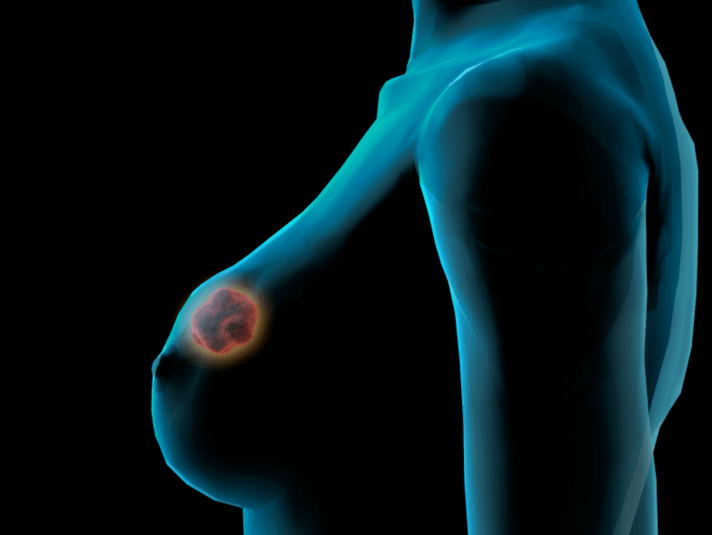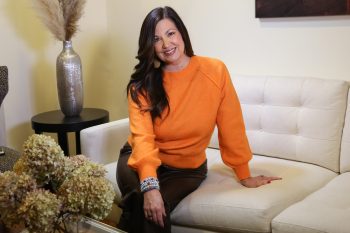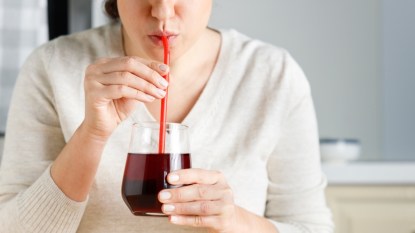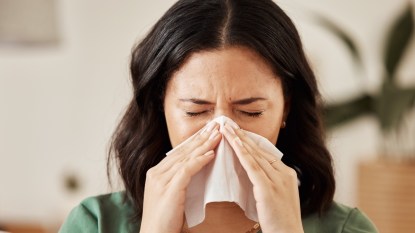My ‘Dense Breasts’ May Have Put Me at Higher Risk for Breast Cancer

Perhaps you’ve heard of ‘dense breasts’ – you may even have been told by your OB-GYN that you have them: 40 percent of American women are in the Dense Breast Club. Until I had my first mammogram, at age 40, I’d never heard the term. When the radiologist looked at my mammogram results on her screen, and told me, in a nonchalant tone of voice, that my breasts were dense, I asked what she meant. She explained that when breasts are classified as dense it simply means that they have more fibrous than fatty tissue. And, I learned later on, the more dense your breasts are, the greater your risk of developing breast cancer.
What are dense breasts?
Dense breasts are perfectly normal and there’s no rhyme or reason to who has them– they’re not connected with size or with firmness. Breast density is influenced by body mass index (BMI): As BMI increases, breast density tends to decline. Dense breasts are more common in younger women, but older women can have them too. Breast density is often inherited, but not always.
“The only way to really know someone’s breast density is if they have a mammogram: The whiter the mammogram, the denser the breast tissue. The darker the mammogram, the fattier the breast tissue,” says Dr. Karla Kerlikowske, of the UCSF Helen Diller Family Comprehensive Cancer Center in San Francisco.
My breast tissue showed up on my mammogram as white as a snowflake. What the radiologist didn’t tell me that day, but I soon learned, once I began my breast cancer journey in earnest, is that having dense breasts is one of the key risks factors for breast cancer because of the high cellular content of the breast tissue.
It’s important for women to know these three key points about breast density:
- Women with dense breasts are at greater risk of developing breast cancer in the first place
- There’s less likelihood of the cancer being detected on a mammogram
- There’s also a higher risk of high-grade (more quickly growing and spreading) cancer
Dense Breasts and Cancer: They Make It More Difficult to Spot
When I was diagnosed with breast cancer, it wasn’t as simple as spotting cancer on my mammogram. A tricky thing about dense breasts is that they’re masters at camouflage — fibrous tissue shows up white on a mammogram — and so do suspicious cells which could be cancer. Trying to identify these within dense breasts can be like trying to find a little white rabbit in the middle of a big snowstorm. The radiologist noticed some shadows, but couldn’t be sure they weren’t normal. Three mammograms later (we tried different positions, but none revealed what the ‘shadows’ were), one ultrasound and one vacuum biopsy later, I was diagnosed with early stage breast cancer, and my ‘hiding’ cancer cells turned out to be high grade — important to remove as soon as possible.
Dense Breasts Screenings
My screening and breast cancer identification route wasn’t unusual — supplementing a mammogram with an ultrasound significantly increases detection success rates in women with dense breasts. When I went in for that first mammogram, I’d assumed, as I imagine most women do, that the picture the radiologist would see on her screen would be perfectly clear and normal. I had no family history of breast cancer. I hadn’t been aware that my breasts were dense, nor that I had several other risk factors. So, the citing of suspicious looking areas on the mammogram hit me straight out of left field. Thankfully, my cancer was found early enough that it could be removed fairly easily – after the vacuum biopsy, I went on to have a lumpectomy and, later, radiotherapy. Because the cancer hadn’t yet spread very far, I was able to avoid chemotherapy and a mastectomy.
I live in the U.K, where screenings within the national health service typically start at aged 50. My breast surgeon told me that had I not had that mammogram when I was 40, the high-grade cancer cells in my breast would have, most likely, become invasive within one to two years. The only reason I had a mammogram in the first place was because I have private health insurance through my teaching job, and they offer a free mammogram every year after 40. I feel privileged to have been in this position of early identification, and I can’t help but feel that the age for screening in my country needs to be lowered. (These are the guidelines from the American Cancer Society for screenings in the U.S.)
Over 20 U.S. states have now passed legislation which requires your radiologist to tell you if your breasts are dense. Armed with this knowledge, you can take yourself in for annual screenings, and/or ask for a 3D mammogram or ultrasound (much more effective than 2D mammograms at spotting cancer in women with very dense breasts).
There’s some debate among doctors about how often you should be screened if you have dense breasts; having dense breasts alone might not, on its own, be a reason for additional screening (it’s only women with extremely dense breasts who may need to be screened more often).
Dense Breasts After Menopause
Breast density declines after menopause, but not by much – by about 2 % per year. Several recent studies have found that higher breast density in post-menopausal women increases the risk of specific types of breast cancer. Also, it’s important to know that HRT tends to increase breast density: “The real increase is for people who take estrogen plus progestin,” says Dr. Kerlikowske: “It’s thought that the progestin component is what increases breast density. Estrogen-progestin therapy lends the same risk of breast cancer as that of a pre-menopausal woman with dense breasts.”
Age is still widely regarded as the number one risk factor for breast cancer — and it turns out almost half of all breast cancers in women aged 50 to 69 aren’t found on a mammogram, but by the women themselves or their doctors. Regular self-examinations can pay dividends.
Keep a Healthy Perspective
There are a multitude of factors which can contribute to breast cancer cells developing and growing. Breast density is undoubtedly one of the factors: Studies show that the risk of getting breast cancer for women with dense breasts is up to six times higher. Doctors still don’t know exactly why this is the case.
If, like me, you have dense breasts, don’t panic. Focus on the whole picture – knowledge is definitely power. Now that I am aware of my breast density and I know how good cancer is at hiding within all that fibrous tissue, I’ll be requesting an ultrasound alongside a yearly 3D mammogram.
Dense breasts or not, common sense is key in breast cancer prevention. Keeping to a healthy weight, eating well, laying off alcohol and cigarettes and exercising regularly will all help reduce your risk of getting breast cancer. Leading a healthy lifestyle helps your immune system to best do its thing and to fight off those cancer cells, too.
This article was written by Amy Schreibman Walter.
More from FIRST
This Grocery Store Staple Slashes Your Breast Cancer Risk













